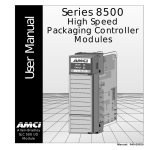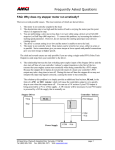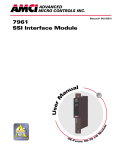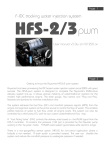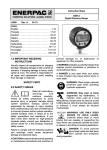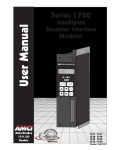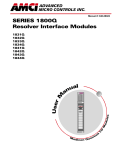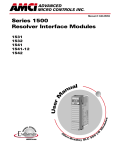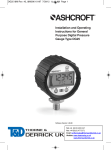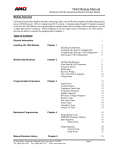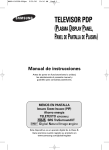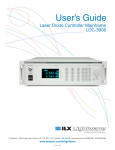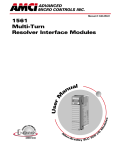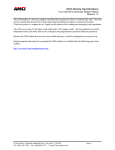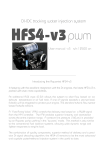Download User Manual - Advanced Micro Controls Inc
Transcript
User Manual 2541 High Speed Programmable Limit Switch Module Allen-Bradley SLC 500 I/O Module Manual: 940-05071 GENERAL INFORMA TION INFORMATION Important User Information The products and application data described in this manual are useful in a wide variety of different applications. Therefore, the user and others responsible for applying these products described herein are responsible for determining the acceptability for each application. While efforts have been made to provide accurate information within this manual, AMCI assumes no responsibility for the application or the completeness of the information contained herein. Throughout this manual the following two notices are used to highlight important points. WARNINGS tell you when people may be hurt or equipment may be damaged if the procedure is not followed properly. CAUTIONS tell you when equipment may be damaged if the procedure is not followed properly. No patent liability is assumed by AMCI, with respect to use of information, circuits, equipment, or software described in this manual. The information contained within this manual is subject to change without notice. UNDER NO CIRCUMSTANCES WILL ADVANCED MICRO CONTROLS, INC. BE RESPONSIBLE OR LIABLE FOR ANY DAMAGES OR LOSSES, INCLUDING INDIRECT OR CONSEQUENTIAL DAMAGES OR LOSSES, ARISING FROM THE USE OF ANY INFORMATION CONTAINED WITHIN THIS MANUAL, OR THE USE OF ANY PRODUCTS OR SERVICES REFERENCED HEREIN. Standard Warranty ADVANCED MICRO CONTROLS, INC. warrants that all equipment manufactured by it will be free from defects, under normal use, in materials and workmanship for a period of [1] year. Within this warranty period, AMCI shall, at its option, repair or replace, free of charge, any equipment covered by this warranty which is returned, shipping charges prepaid, within one year from date of invoice, and which upon examination proves to be defective in material or workmanship and not caused by accident, misuse, neglect, alteration, improper installation or improper testing. The provisions of the “STANDARD WARRANTY” are the sole obligations of AMCI and excludes all other warranties expressed or implied. In no event shall AMCI be liable for incidental or consequential damages or for delay in performance of this warranty. Returns Policy All equipment being returned to AMCI for repair or replacement, regardless of warranty status, must have a Return Merchandise Authorization number issued by AMCI. Call (860) 585-1254 with the model and serial numbers along with a description of the problem. A “RMA” number will be issued. Equipment must be shipped to AMCI with transportation charges prepaid. Title and risk of loss or damage remains with the customer until shipment is received by AMCI. 24 Hour Technical Support Number 24 Hour technical support is available on this product. For technical support, call (860) 583-7271. Your call will be answered by the factory during regular business hours, Monday through Friday, 8AM - 5PM EST. During nonbusiness hours, an automated system will ask you to leave a detailed message and the telephone number that you can be reached at. The system will page one of two engineers on call. Please have your product model number and a description of the problem ready before you call. ADVANCED MICRO CONTROLS INC ABOUT THIS MANUAL Introduction This manual explains the operation, installation, and programming of the 2541 High Speed Programmable Limit Switch for Allen-Bradley SLC 500™ systems. It is strongly recommended that you read the following instructions. If there are any unanswered questions after reading this manual, call the factory. An applications engineer will be available to assist you. AMCI is a registered trademark of Advanced Micro Controls Inc. The AMCI is a trademark of Advanced Micro Controls Inc. SLC and SLC 500 are trademarks of Allen-Bradley Company. This product incorporates technology which is licensed by Allen-Bradley Company, Inc. AllenBradley has not technically approved, nor does it support this product. All warranty and support for this product and its application is provided solely by Advanced Micro Controls Inc. Manuals at AMCI are constantly evolving entities. Your questions and comments on this manual and the information it contains are both welcomed and necessary if this manual is to be improved. Please direct all comments to: Technical Documentation, AMCI, 20 Gear Drive, Plymouth Industrial Park, Terryville CT 06786, or fax us at (860) 584-1973. Revision Record The following is the revision history for this manual. In addition to the information listed here, revisions will fix any known typographical errors and clarification notes may be added. This manual, 940-05071, supersedes 940-05070. The changes reflect the change to the limit switch output connector from an eight pin green connector to a nine pine black connector. This hardware change was made to distinguish the LS output connector from the transducer input connector. The revision was first released April 14, 1999. Past Revisions 940-05070: Initial Release, 3/31/1999 20 Gear Drive, Plymouth Ind. Park, Terryville, CT 06786 Tel: (860) 585-1254 Fax: (860) 584-1973 1 ABOUT THIS MANUAL Notes 2 ADVANCED MICRO CONTROLS INC 1 2541 INTRODUCTION Overview Until the introduction of AMCI’s PLS modules, interfacing a high speed programmable limit switch to a SLC 500 programmable controller was a difficult task. Additional I/O wiring, separate panel mounting, and perhaps even a custom serial protocol were needed to interface the PLS and SLC together. A 2541 Resolver PLS module eliminates all of these difficulties. The 2541 plugs into the SLC 500 I/O rack and is under the complete control of processor. All programming is accomplished over the backplane using the I/O data tables and two M files. The many features of the 2541 makes it the most advanced PLS module on the market today. ! ! ! ! ! ! ! ! ! ! ! Uses a brushless resolver based transducer for position feedback. Programmable position resolution from 2 to 4,096 counts per turn. Programmable position offset. Position preset function Tachometer Scalars allow you to scale the tachometer value to any meaningful unit of measure, not just RPM. Six limit switch outputs: ! 100µS update time. ! 100mA @ 28Vdc rated drivers. ! Eight on/off setpoint pairs per output. Figure 1.1 2541 Module ! Separate on/off automatic advances for speed compensation. ! Can be programmed as position, timed, or pulsed limit switches A limit increment/decrement function that allows you to ‘tweak’ limit switch settings on the fly. Four 30Vdc inputs that allow you to disable the first four outputs based on external conditions. Two programmable motion detectors that allow you to independently disable any of the outputs based on machine speed. Programmable on/off force bits that allow you to set an output to a given state regardless of programming and conditions. Extensive fault detection routines continuously monitor the integrity of the module, transducer, and transducer cabling. 20 Gear Drive, Plymouth Ind. Park, Terryville, CT 06786 Tel: (860) 585-1254 Fax: (860) 584-1973 3 1 INTRODUCTION Overview (continued) The 2541 is programmed for the backplane using a combination of I/O data words and two M files. You can easily read back any data sent to the module. Also, all of the data generated by the module is reported to the processor. This includes the Position, position offset, and tachometer values as well as the status of the limit switches, the inputs, and the motion detectors. Therefore you can report this data to an operator using a remote display, generate other limit switches in ladder logic, or use this data in any other way appropriate to your machine. With the use of M files, the SLC processor in the system must be a 5/02 or above. Fixed SLC systems and 5/01 processors cannot be used. The use of M files also restricts the 2541 to local or local extended racks. The 2541 cannot be used in a remote rack. Programmable Parameters You configure the 2541 by setting its Programmable Parameters. The programmable parameters are broken down in the following three groups: 4 ! Module Setup Parameters – Parameters that setup the tachometer, motion detectors, and active state of the inputs. The output on/off force values are also included in these parameters. ! Transducer Setup Parameters – Parameters that affect the position data. ! Limit Switch Parameters – Parameters that program the type of limit switch and any ANDing with the motion detectors as well as setpoint and on/off advances. ADVANCED MICRO CONTROLS INC 1 INTRODUCTION Module Setup Parameters Tachometer Response A bit value that sets how often the 2541 updates the tachometer data to the processor. With a default of 504 mS, the two choices are 504 mS and 120 mS. Internally, the tachometer updates every 24 mSec. This update time is used when calculating the limit switch on/off advance values. Tachometer Scalars The 2541 allows you to scale the tachometer value reported to the processor. Therefore you can have the module report a tachometer value scaled to boxes per minute, inches per minute, or any other meaningful value instead of revolutions per minute. The tachometer is scaled with three values, Tach Multiplier, Tach Divisor, and Tach Decimal Point. The tachometer reports the rounded off integer value of the equation: ! (((Speed[RPM] * Tach Multiplier) / Tach Divisor ) / Tach Decimal Point). The Tach Multiplier can be any integer between 0 and 1,100. The Tach Divisor can be any integer between 1 and 63. The Tach Decimal Point can be 1, 10, 100, or 1000. As an example, assume a speed of 100 RPM, a multiplier of 2, a divisor of 3. The table below shows the different tachometer values based on the Tach Decimal Point value. DECIMAL POINT VALUE 1 10 100 1000 Calculated Tach 66.67 6.67 0.67 0.067 Reported Tach 67 7 1 0 Table 1.1 Effect of Tachometer Scalars When programming the Tach Decimal Point, you will enter a value of 0, 1, 2, or 3 into your programming data. This corresponds to a Tach Decimal Point value of 1, 10, 100, or 1,000. Input Active State These four bit values program the active state of the four inputs on the front of the module. When an Active State bit is set to its default value of zero, the corresponding input works like a normally closed relay. The input must have current flowing through it to be deactivated. When an Active State bits is set to one, the corresponding input works like a normally open contact. The input must have current flowing through it to be active. ! If you are not using the inputs, leave the Input Active State bits in their default reset state. The outputs will then fire without anything attached to the inputs. Input Forces You can force any of the four inputs on or off by setting the appropriate bit in the output image table. A Force OFF bit take precedence over the corresponding Force ON bit. 20 Gear Drive, Plymouth Ind. Park, Terryville, CT 06786 Tel: (860) 585-1254 Fax: (860) 584-1973 5 1 INTRODUCTION Module Setup Parameters (continued) Output Forces You can force any output on or off by setting the appropriate bit in the output image table. A Force OFF bit take precedence over the corresponding Force ON bit. ! If your application does not require six limit switch outputs, you can use any uncommitted limit switch output as a standard DC output by referencing the Force ON bit. Motion Detector ON/OFF setpoints The 2541 has two motion detectors, MD1 and MD2, that function as speed based limit switches. You program a low speed setpoint and a high speed setpoint for each motion detector. If the low speed setpoint is less than the high speed setpoint then the output will be on when the velocity is between the two setpoints and off at all other speeds. If the low speed setpoint is greater than the high speed setpoint then the output will be off when the velocity is between the two setpoints and on at all other speeds. You can logically AND any limit switch output with either motion detector. This disables the limit switch unless the machine is running within the programmed range. The motion detector setpoints are always programmed in RPM, regardless of the values of the Tachometer Scalars. The motion detector setpoints have a range of zero to 32,767 RPM. The state of the motion detectors is updated when the tachometer value is calculated. Therefore, the motion detectors update every 102 or 504 mS, based on the value of the Tachometer Response parameter. If you are using the motion detectors to disable limit switch outputs on a machine that accelerates quickly, you may have to change the Tachometer Response parameter from its default of 502 mS to 120 mS. This insures that the limit switches will be enabled as quickly as possible once the machine is at operating speed. 6 ADVANCED MICRO CONTROLS INC INTRODUCTION 1 Transducer Setup Parameters Count Direction A bit value that sets the direction the transducer shaft must rotate to increase the position value. It defaults to clockwise and can be set to clockwise or counter-clockwise. Note that it is also possible to reverse the count direction by switching one of the pairs in the transducer cable. Scale Factor Sets the position resolution of the 2541 module. It defaults to 4,096 counts per turn and is programmable to any value between 2 and 4,096. PresetValue The value that the position data will be set to when you preset it from the backplane. With a default of zero, it is programmable to any value between 2 and (Scale Factor - 1). See Position Offset below for more information on how the Preset Value works. Position Offset This number is added to the absolute resolver position to calculate the position value of the 2541. With a default of zero, it is programmable to any value between 2 and (Scale Factor - 1). The Position Offset give you the ability to set the Position value to any value without rotating the transducer shaft. 1) Presetting the position forces the module to recalculate the Machine Offset. 2) The 2541 does not store the Position Offset in non-volatile memory but the value is placed in its M0 file and available to the processor as a data word. In order to keep the position value absolute, you must store the Position Offset in an integer file and write it down to the 2541 every time you configure the module. If you do not do this, you will have to reset the machines position every time you cycle power. 20 Gear Drive, Plymouth Ind. Park, Terryville, CT 06786 Tel: (860) 585-1254 Fax: (860) 584-1973 7 1 INTRODUCTION Limit Switch Parameters Limit Switch Type Parameter Programs the type of limit switch the output channel will be. The three choices are Normal, Timed, and Pulse. Normal outputs turn on and off based on position. Timed outputs function like a timing relay, turning on at a programmed position and remaining on for a programmed length of time. Pulse outputs generate a pulse train between two position values. Motion ANDing Parameter You can disable the a limit switch output by ANDing it with one of the two motion detectors. This prevents the output from firing until the machine is running within the range set by the motion detector. This parameter specifies which motion detector is ANDed with the limit switch output. You can also choose not to AND the output with either motion detector. Limit Switch ON / OFF Setpoints Limit switch setpoints are pairs of position values that set where the outputs turn on and off. Setpoints can be programmed to any value between zero and (Scale Factor - 1). Normal Limit Switch – Eight pairs of ON / OFF setpoints that give you the ability to turn the output on and off eight times per turn. If the ON setpoint is less than the OFF setpoint, the output is on when the position value is between the two limits and off when outside the limits. If the ON setpoint is greater than the OFF setpoint, the output is off when the position value is between the two limits and on when outside the limits. Pulse Limit Switch – One ON / OFF setpoint pair that sets the leading edge of the first pulse in the train and the trailing edge of the last pulse in the train. Two additional parameters set the total number of pulses in the train and the number of counts that each pulse is on. Timed Limit Switch – One ON / OFF setpoint pair that sets the ON position and off position of the limit. A third parameter sets the amount of time the output is on. Usually, the output will turn on at the ON setpoint and remain on for the specified length of time. However, if the OFF setpoint is reached before the output times out, then the output will turn off. The maximum length of time an output can be on is 9.999 seconds. Limit Switch ON / OFF Advances Two parameters that allow the limit switch channel to compensate for fixed delays in the system by turning on or off before or after the actual programmed setpoint. The maximum compensation is ±99.9 mSec. Setting the Advance to a positive value will force the output to turn on at an earlier position. Setting the Advance to a negative value will force the output to turn on at a later position. 8 ADVANCED MICRO CONTROLS INC 2 INSTALLATION This chapter describes how to install a Series 8500 system. It covers module, transducer, and relay board installation and the cabling needed to connect the components together. System Requirements Processor Requirements A 2541 uses a M0 and M1 files to communicate with the processor. Therefore the processor used in your system must be a 5/02 or greater. Fixed SLC and 5/01 processors cannot be used with the 2541 module. Rack Requirements A 2541 must be installed in a local or expanded local rack. Note that the 2541 cannot be installed the processor slot of the expanded local rack. The module cannot be installed in a remote rack because of the use of the M files. Power Requirements A 2541 module draws its power from the I/O rack +5Vdc and +24Vdc supplies. The maximum current draw from the +5Vdc supply is 0.195 amps, (0.98 W). The maximum current draw from the +24Vdc supply under normal operating conditions is 0.035 mA, (0.84 W). If the reference voltage generated by the module is shorted, the current draw from the +24Vdc supply rises to 0.15A, (3.6W) while the power draw on the +5Vdc supply remains the same. Add these power requirements to the requirements of all the other modules in the rack when sizing the power supply. 2541 Connectors Figure 4.1 shows the placement of the I/O and Transducer Input Connectors on the 2541. Status LEDs Shows output and module status. Input LEDs RESOLVER PLS 1 4 2 5 3 6 2541 Shows active state of the four inputs. DC Input Connector For the output disable inputs. Pin 1 on Top LS Output Connector Pin 1 on Top Transducer Input Connector The mates of the Transducer Input and LS Pin 1 on Bottom Output Connectors can be plugged into Figure 4.1 2541 Connectors the wrong connector. Crossing these connections can damage the module if DC power for the limit switches is instead applied to the Transducer Input Connector. Check all wiring before applying power to the 2541. 20 Gear Drive, Plymouth Ind. Park, Terryville, CT 06786 Tel: (860) 585-1254 Fax: (860) 584-1973 9 2 INSTALLATION Installing the Module Remove system power before removing or installing any module in an I/O rack. Failure to observe this warning may result in damage to the module’s circuitry and/or undesired operation with possible injury to personal. 1) Align the modules’ right circuit board with the top and bottom card guides in the rack. 2) Gently slide the module into the rack until the top and bottom latches secure the module in place. To remove the module, depress the top and bottom latches and slide the module out of the rack. Module ID Code All 2541s have an ID Code of 9935. This reserves 8 Input and 8 Output words for the module. When configuring the slot you must also enter the ‘SPIO CONFIG’ menu and specify a M0 File size of 120 words and a M1 File size of 650 words. If you do not configure the M files correctly you will get an error message when you switch the processor to Run Mode. The error message is “M1/M0 File Configuration Error, slot X” were “X” is the slot the 8500 plugs into. If you are using AI software, you must use version 8.15+ to program the M file lengths correctly. Status LED’s The front display has a total of eight LED’s. The six that are numbered are status LED’s for the six outputs. When external power is supplied, these LED’s will light when the corresponding output is on. The other two, labeled ‘RUN’ and ‘FLT’ indicate the operating status of the module. RUN FLT OFF ON COMMENT MODULE FAULT The module failed its power-up diagnostics. Cycle power to the module. If the error still exists, the module must be returned to AMCI for repair. ON ON NON CLEARABLE TRANSDUCER FAULT There is a transducer fault that the module cannot clear. There are six major causes of this fault. !"Broken or intermittent transducer cable !"Non-compatible transducer !"Improper wiring of the transducer cable !"Improper installation of the transducer cable !"Faulty transducer !"Faulty module ON FLASHING CLEARABLE TRANSDUCER FAULT There is a transducer fault that can be cleared with a Clear Errors command from the backplane. A transducer fault of this type is most often caused by a burst of electrical noise, an intermittent connection, or a mis-wired transducer cable. ON OFF MODULE OK The module is operating without any faults. The transducer is operating properly. Table 2.1 Status LED’s 10 ADVANCED MICRO CONTROLS INC 2 INSTALLATION Transducer Input Connector The Transducer Input Connector has eight contacts. The mating connector for the 2541 is not supplied with the module. It comes as part of an AMCI pre-assembled transducer cable or it can be ordered as a separate item. See figure 2.3, C1TP-(x) Wiring Diagram below for the mating connector part numbers. Figure 2.2 shows the connector pin out to industry standard wire designations. 8 7 6 5 4 3 2 1 ! R1/R2 – Reference Winding S3 S1 ! S1/S3 – COS Winding S4 ! S2/S4 – SIN Winding S2 All Shields No Connection R2 R1 Figure 2.2 Transducer Input Connector Transducer Cable Installation Pre-assembled and tested cables are available from AMCI under the part number C1TP-(x), where (x) is the length in feet. Figure 2.3 is a wiring diagram of the C1TP-(x) cable. 1) Resolvers are low voltage, low power devices. If you are using A-B guidelines for cabling installation, treat the transducer cable as a Category 2 cable. It can be installed in conduit along with other low power cabling such as communication cables and low power ac/dc I/O lines. It cannot be installed in conduit with ac power lines or high power ac/dc I/O lines. 2) The shields of the transducer cable must be grounded at the 2541 module only! When installing the cable, treat the shield as a signal conductor. Do not connect the shield to ground at any junction box or the transducer. This will eliminate ground loops that could damage the module or SLC. Transducer Connector BLK WHT S3 S1 S4 6 S2 5 Shields 4 8 7 GRN E AMCI Part #: MS-16 Bendix #: MS3106A16S-1S D BLK F G C SHIELDS A 3 R2 1 R1 RED BLK 2 B Module Connector Mates to all Single Channel Resolver Input and Limit Switch Modules. AMCI Part #: MS-8P Phoenix #: MC1.5/8-ST-3.81 1803633 BELDEN 9873 Cable For Cable lengths greater than 100’ (30 meters) use BELDEN 9730. Figure 2.3 C1TP-(x) Wiring Diagram 20 Gear Drive, Plymouth Ind. Park, Terryville, CT 06786 Tel: (860) 585-1254 Fax: (860) 584-1973 11 2 INSTALLATION Transducer Specifications The following table contains mechanical and environmental specifications for all of the AMCI rotary position transducers that are compatible with the 2541. Specification Shaft Diameter Radial Shaft Loading Axial Shaft Loading Starting Torque Moment of Inertia Weight Enclosure All HT-20 s All H25 s 0.625" 0.375" 40 lbs. Max. 400 lbs. Max. 200 lbs. Max. HT-6 0.188" 8 lbs. Max. 4 lbs. Max. 20 lbs. Max. 8 oz.in. @ 25 C 1.5 oz.in. @ 25 C 20 oz-in-sec† 4 oz-in-sec 2.1 x 10 oz-in-sec† 4 lbs. 1 lb. 0.7 lb. NEMA 13 or 4X NEMA 4 NEMA 13 2 0.5 oz.in. @ 25 C -4 Environmental (All Transducers) Operating Temp -20 to 125 C Shock 50G s for 11 mSec Vibration 5 to 2000 Hz @ 20 G s Table 2.2 Transducer Specifications F A G E D B C All of the AMCI transducers that are compatible with the S1 (RED) S3 (BLK) 2541 have the same connector. The connector pin out to R1 (RED/WHT) industry standard wire designations is given in figure 2.4. R2 (BLK/WHT) S2 (YEL) S4 (BLU) Figure 2.4 Transducer Connector Pin Out Transducer Mounting All AMCI resolver based transducers are designed to operate in the industrial environment and therefore require little attention. However, there are some general guidelines that should be observed to ensure long life. ! Limit transducer shaft loading to the following maximums: Radial Load Axial Load All HT-20 Transducers 100 lbs. (445 N) 50 lbs. (222 N) All H25 Transducers 30 lbs. (133 N) 15 lbs. (66.7 N) All Other Transducers 4 lbs. (17.8 N) 2 lbs. (8.9 N) Table 2.3 Transducer Bearing Loads 12 ADVANCED MICRO CONTROLS INC 2 INSTALLATION Transducer Mounting (continued) ! Minimize shaft misalignment when direct coupling shafts. Even small misalignments produce large loading effects on front bearings. It is recommended that you use a flexible coupler whenever possible. ! The transducer housing must be connected to Earth Ground. This is usually accomplished through its mounting. If not properly grounded through its mounting, run a heavy guage wire from the transducer housing to an Earth Ground point as close as possible to the transducer. Transducer Outline Drawings AMCI offers a broad line of resolver based transducers for use with the 2541 module. Outline drawings of selected transducer are included here in the manual. Listed below are the transducer outline drawings that are not included. Contact AMCI if you need one of these outline drawings. They will be faxed to you upon request. ! ! ! ! ! R11X-J10/7 ............ R11X-J12/7 ............ HT-6 ....................... HT-20C ................... H25FL & H25SL .... NEMA 1 Size 11 Resolver, 0.120” Shaft NEMA 1 Size 11 Resolver, 0.188” Shaft NEMA 13 R11X-J12/7 Resolver NEMA 4X Stainless Steel Transducer NEMA 4 Size 25 Transducers, Integral Cable HT-20: Anodized Aluminum Body, 1070 Steel Shaft, NEMA 13 2.500" 4.75" (63.5) (120.7) KEYWAY 2.000" (50.8) .106(2.69) .1885(4.79) DEEP X 1.0(25.4) X .108(2.74) .1895(4.81) 1.000" 0.750" 3.250" (19.05) (82.6) 0.500" (12.7) KEY (25.4) .187(4.75) SQ. X 1.0(25.4) .188(4.78) 1.000" (25.4) 2.500" 2.000" (63.5) (50.8) 1.180 Dia. 1.500" (30) (38.1) 0.250" (6.35) 0.6247" (15.87) 0.6237" (15.84) 0.250" 0.150" (6.35) (3.81) 1/4-20 UNC-2B 0.500"(12.7) DEEP 8 PLACES 1.25" (31.8) MS3102E16S-1P CONNECTOR 0.700" (17.78) MAX. TOTAL CLEARANCE OF 3.5"(89) NEEDED FOR REMOVAL OF MATING CONNECTOR Figure 2.5 HT-20 Outline Drawing 20 Gear Drive, Plymouth Ind. Park, Terryville, CT 06786 Tel: (860) 585-1254 Fax: (860) 584-1973 13 2 INSTALLATION AMCI Transducer Outline Drawings (continued) HT-20S: Anodized Aluminum Body, 1070 Steel Shaft, NEMA 13 2.500" 4.75" (63.5) (120.7) 0.600" (15.24) MAX. 2.000" (50.8) KEYWAY 1.000" .1885(4.79) .106(2.69) DEEP X 1.0(25.4) X .1895(4.81) .108(2.74) (25.4) 0.750" 3.250" (19.05) (82.6) 0.500" (12.7) KEY .187(4.75) SQ. X 1.0(25.4) .188(4.78) 1.000" (25.4) 2.500" 2.000" (63.5) (50.8) 0.250" 1.180 Dia. 1.500" (30) (38.1) (6.35) 0.6247" (15.87) 0.6237" (15.84) 0.250" 0.150" (6.35) (3.81) MS3102E16S-1P CONNECTOR TOTAL CLEARANCE OF 3.5"(89) NEEDED FOR REMOVAL OF MATING CONNECTOR 1/4-20 UNC-2B 0.500"(12.7) DEEP 8 PLACES 1.25" (31.8) Figure 2.6 HT-20S Outline Drawing HT-20K: Hard Coat Anodized Aluminum Body, Stainless Steel Shaft, NEMA 4X 2.500" (63.5) HT-20K SUPPLIED WITH VITON SHAFT SEAL HT-20L SUPPLIED WITH NITRILE SHAFT SEAL 4.75" (120.7) KEYWAY 2.000" (50.8) .106(2.69) .1885(4.79) DEEP X 1.0(25.4) .1895(4.81) X .108(2.74) 1.000" 0.750" 3.250" (19.05) (82.6) 0.500" (12.7) KEY (25.4) .187(4.75) SQ. X 1.0(25.4) .188(4.78) 1.000" (25.4) 2.500" 2.000" (63.5) (50.8) 1.180 Dia. 1.500" (30) (38.1) 0.250" (6.35) 0.6247" (15.87) 0.6237" (15.84) MS3102E16S-1P CONNECTOR 0.250" (6.35) 1/4-20 UNC-2B 0.500"(12.7) DEEP 8 PLACES 1.25" (31.8) 0.700" (17.78) MAX. TOTAL CLEARANCE OF 3.5"(89) NEEDED FOR REMOVAL OF MATING CONNECTOR Figure 2.7 HT-20K Outline Drawing 14 ADVANCED MICRO CONTROLS INC 2 INSTALLATION Transducer Outline Drawings (continued) H25SE & H25FE: Anodized Aluminum Body, 1070 Steel Shaft, NEMA 4 #8-32 UNF 2B THD X 0.18 (4.57) MIN DEPTH 6 PLACES 60 APART ON A 1.875 ( 47.63) B.C. 0.300 MS3102E16S-1P CONNECTOR (7.62) 0.3747 (9.52) 0.3744 (9.51) 2.31 (58.7) DIA H25SE Servo Mount End Connector 0.875 –0.025 (22.23–0.64) 0.100 (2.54) 0.100 (2.54) 1.250 (31.75) 1.249 (31.72) 2.50 (63.5) 3.20 (81.3) MAX Additional 3.5 (89) clearance needed for mating connector removal. 2.65 (67.3) 0.250 (6.35) 1.032 (26.21) TYP 1.032 (26.21) TYP 0.300 MS3102E16S-1P CONNECTOR (7.62) 2.65 (67.3) 0.3747 (9.52) 0.3744 (9.51) H25FE Flange Mount End Connector 1.250 (31.75) 1.249 (31.72) 0.875 –0.025 (22.23–0.64) 0.218 (5.54) DIA 4 PLACES Figure 2.8 H25FE and H25SE Outline Drawing 20 Gear Drive, Plymouth Ind. Park, Terryville, CT 06786 Tel: (860) 585-1254 Fax: (860) 584-1973 15 2 INSTALLATION Transducer Outline Drawings (continued) H25SS & H25FS: Anodized Aluminum Body, 1070 Steel Shaft, NEMA 4 MS3102E16S-1P CONNECTOR #8-32 UNF 2B THD X 0.18 (4.57) MIN DEPTH 6 PLACES 60 APART ON A 1.875 ( 47.63) B.C. 2.65 (67.3) MAX 0.300 Additional 3.5 (89) clearance needed for mating connector removal. (7.62) 0.3747 (9.52) 0.3744 (9.51) 2.31 (58.7) DIA H25SS Servo Mount Side Connector 0.875 –0.025 (22.23–0.64) 0.100 (2.54) 0.100 (2.54) 1.250 (31.75) 1.249 (31.72) 2.50 (63.5) 2.70 (68.6) MAX MS3102E16S-1P CONNECTOR 2.65 (67.3) MAX Additional 3.5 (89) clearance needed for mating connector removal. 0.300 (7.62) 2.65 (67.3) 0.3747 (9.52) 0.3744 (9.51) H25FS Flange Mount Side Connector 1.250 (31.75) 1.249 (31.72) 1.032 (26.21) TYP 0.875 –0.025 (22.23–0.64) 1.032 (26.21) TYP 2.65 (67.3) 0.218 (5.54) DIA 4 PLACES 0.250 (6.35) 2.65 (67.3) MAX Figure 2.9 H25SS and H25SS Outline Drawing 16 ADVANCED MICRO CONTROLS INC 2 INSTALLATION Input Wiring Input Connector Figure 2.10 shows the pin out of the Input Connector and a simplified schematic of the Input 1. The schematics for the other inputs is identical. Note that pin one is at the top of the connector when plugged into the module, not at the bottom as it is with the Transducer Input Connector. Input LED’s GRN RED Optocoupler 1 2 3 4 5 Input 1 Input 2 Input 3 Input 4 Input Common Figure 2.10 Input Connector Pin Out Input LED’s There are eight LED’s above the Input Connector that show the on/off status of the inputs. There are two LED’s for each input. The LED that lights is dependent on how the inputs are wired, either as sinking or sourcing inputs. Because the inputs share a single common, they must be all wired as the same type of input, either sinking or sourcing. Sinking Inputs (Red) Input 1 ON Input 2 ON Input 3 ON Input 4 ON Sourcing Inputs (Green) Input 1 ON Input 2 ON Input 3 ON Input 4 ON Figure 2.11 Input LED’s 20 Gear Drive, Plymouth Ind. Park, Terryville, CT 06786 Tel: (860) 585-1254 Fax: (860) 584-1973 17 2 INSTALLATION Input Wiring (continued) Connector Wiring Figure 2.12 shows how to wire the inputs as sourcing inputs. Wiring them as sinking inputs only involves switching the positive and negative power supply leads. Note that you cannot wire one input as a sourcing input and another as a sinking input. Because they share a common pin, they must all be wired as the same type. The figure assumes that relays are used to activate the inputs. The note on setting the Input Active State parameters assumes that you want the limit switch output active when the relay is in it unpowered state. If you want the limit switch outputs active when the relays are powered, use the other state of the bit when programming the Input Active state parameters. Shielded cable should be used to help with noise immunity. Treat the shield as a signal carrying conductor and ground it only at the power supply. Do not ground the shield at junction boxes or the 2541 module. This will help to eliminate potential ground loops in your system. Shield 1 POWER SUPPLY 8-24 Vdc Input requires a minimum of 5mA to activate. + Input Electrical Specs Voltage Differential (Common to Input or Input to Common) Logic 0 = 0 to 2Vdc Logic 1 = 8 to 30 Vdc 2 3 4 5 When using a Normally Open contact to activate the input, program the corresponding Input Active State bit to ’0’. to enable the output when the relay is off. When using a Normally Closed contact to activate the input, program the corresponding Input Active State to ’1’ to enable the output when the relay is off. Figure 2.12 Input Wiring 18 ADVANCED MICRO CONTROLS INC 2 INSTALLATION Output Wiring Output Connector Figure 2.13 shows the pin out of the LS Output Connector and a simplified schematic of Output 1. The schematic for the other outputs is identical. Note that pin one is at the top of the connector, not at the bottom as it is with the Transducer Input Connector. 1 No Connection 2 +Vdc IN Flyback 3 COMMON Diode Output Voltage: 8 to 28 Vdc 4 Output 1 5 Output 2 Output Current: 150 mA per 6 Output 3 output @ 60°C 7 Output 4 8 Output 5 Status 9 Output 6 LED Figure 2.13 LS Output Connector Pin Out The Flyback Diode is built-in protection for the driver againist voltage spikes from mechanical relays or other inductive loads. However, you should still install a surge suppression device across any inductive load attached to the 2541. This will greatly decrease the amount of electrical noise generated by the load when it turns on and off. Note that your power supply must be attached to the +Vdc IN and COMMON terminals of the connector for the Flyback Diode to work properly. The Status LED is one of the six numbered LED’s on the front panel. It will turn on when the LS Output is on and your power supply is attached to the +Vdc IN and COMMON terminals of the connector. Connector Wiring Figure 2.14 shows how to wire an output. The other five outputs are wired identically. Note that a single power supply must be used to power all of the outputs because they share power supply connections. All power suppluy connections to the loads must be Power Supply 8-24 Vdc + If the power supply is to be earth grounded, make the connection as close to the supply as possible. Use 14 AWG min. wire for the power supply connections. made as close to the power supply as possible. This limits the amount of electrical noise induced from one load into another. 1 No Connection 1 2 2 +Vdc IN 3 3 COMMON 4 4 Output 1 LOAD 1 5 5 Output 2 6 6 Output 3 7 7 Output 4 LOAD 2 8 8 Output 5 9 9 Output 6 All inductive loads must have surge surge suppression devices installed across thier terminals. This limits the amount of electrical noise generated by the load. 20 Gear Drive, Plymouth Ind. Park, Terryville, CT 06786 Tel: (860) 585-1254 Fax: (860) 584-1973 Figure 2.14 Limit Switch Output Wiring 19 2 INSTALLATION Notes 20 ADVANCED MICRO CONTROLS INC 3 BACKPLANE PROGRAMMING A 2541 module communicates with the SLC processor through two ‘M’ files as well as the Output and Input Image Tables. The 2541 is configured with data stored in its M0 and M1 data files. The Output Image Table is used to quickly adjust limit switch setpoints and force the module’s I/O on or off. The Input Image Table is used to transmit position, tachometer, and limit switch status as well as global error information. This chapter details how to use this data to configure and run the 2541 module. File Addressing In this chapter, file addresses are defined in the following manner: I:X.n O:X.n M0:X.n M1:X.n Input Image Table Output Image Table M0 file M1 file Where: ‘X’ is the slot number of the 2541 and ‘n’ is the word number in the file. When referring to a specific bit in a word, the characters “/bb” will be appended where ‘bb’ is the bit address. The M0 file has a total lenght of 120 words, and the M1 file has a total length of 650 words. If you are using AI software, you must use version 8.15+ to program the M file lengths correctly. Programming Cycle Programming changes are written to the module with a Programming Cycle. All parameters, except for I/O Forces, are programmed through Programming Cycles. Programming Cycles are controlled with a Transmit Bit and associated Acknowledge Bit. In order to simplify programming, the Programmable Parameters are broken down into two groups. Therefore, there are two Transmit / Acknowledge Bit pairs that control the three Programming Cycle that setup the module. A third Transmit / Acknowledge Bit pair controls the Limit Switch Increment / Decrement Programming Cycle. A Programming Cycle consists of six steps. 1) Write the new data in the correct memory locations. The programming data is stored in one of the two M files or the Output Image Table. 2) Set the appropriate Transmit Bit. The 2541 will not act on the new programming data until the Transmit bit is set. 3) Once the 2541 is done with the programming data it will set the appropriate Acknowledge Bit and any necessary error bits. 4) Once your ladder logic sees the Acknowledge Bit set, check for any errors. 5) Reset the Transmit Bit after you’ve responded to any errors. 6) The 2541 responds by resetting the Acknowledge Bit. The Programming Cycle is complete. 20 Gear Drive, Plymouth Ind. Park, Terryville, CT 06786 Tel: (860) 585-1254 Fax: (860) 584-1973 21 3 PROGRAMMING Programming Groups I/O Forces I/O Forces are stored in the Output Image Table. The 2541 acts on these bits continuously. If one of these bits is set, the module will force the associated input or output within one processor scan time. Setup Data: M0:X.0 – M0:X.19 All Transducer Setup Parameters and all Module Setup Parameters except for I/O Forces are stored in the M0 file between addresses M0:X.0 and M0:X.19. M0:X.0/15 is the Transmit Bit for this programming group. I:X.0/13 is the Acknowledge bit for this programming group. Limit Switch Data: M1:X.0 – M0:X.629 All Limit Switch Setup Parameters are stored in the M1 file between addresses M1:X.0 and M1:X.629. M1:X.0/15 is the Transmit Bit for this programming group. I:X.0/15 is the Acknowledge bit for this programming group. LS Increment / Decrement Data: O:X.0 This word in the Output Image Table give you the ability to increment or decrement limit switch setpoints while the machine is running to fine tune limit switch settings. O:X.0/15 is the Transmit Bit for the LS Increment / Decrement Data. I:X.0/12 is the Acknowledge Bit for the LS Increment / Decrement Data. Error Handling The 2541 stops accepting new parameters once it sets a programming error bit. How you respond to the error depends on your application. However, to reset the programming error in the 2541 you must go through a Programming Cycle with a Clear Errors bit set. Each programming group has a Clear Error bit that acts globally. Setting any of these bits will clear all of the errors in the module. Consider using the Clear Error bit in the Output Image Table. You do not need to write down any additional programming data when using this Clear Errors bit which give you the ability to write a single “Clear Errors” Programming Cycle that can be used at any time. 22 ADVANCED MICRO CONTROLS INC 3 PROGRAMMING Input Image Table Figure 3.1 shows the format of the Input Image Table data. I:X.0 contain Error and Acknowledge Bits. The other data words contain position and tachometer data as well as limit switch and Real Input status data. Input Image Table Word 1 Machine Position Data Word 2 Tachometer Data (Scaled Value) Word 3 Word 4 Word 5 RESERVED: Set to zero. 0 SUFlt LSFlt I/DSet I/DNum MsgIgn TrFlt ModErr MD1 MD2 0 TachOv I/DAck 0 SUAck Word 0 LSAck 15 14 13 12 11 10 09 08 07 06 05 04 03 02 01 00 LS Output Status LS6 LS1 RESERVED: Set to zero. RESERVED: Set to zero. Input Status IN4 IN1* Word 6 RESERVED: Set to zero. Word 7 RESERVED: Set to zero. Bit 0 = LS1, Bit 1 = LS2, Bit 4 = LS5, Bit 5 = LS6 * Bit 0 = IN1, Bit 1 = IN2, Bit 2 = IN3, Bit 3 = IN4 Figure 3.1 Input Image Table Data Format Status Bits SUErr: Setup Error, I:X.0/00. Because parameter values are not stored in non-volatile memory, this bit is set on every power up. It is also set if there is an error in the setup programming data, M0:X.0 – M0:X.19, after a Programming Cycle tries to set these parameters. If this bit is set after a Programming Cycle, status bits in M0:X.100 – M0:X.109 show the exact error. LSErr: Limit Switch Error, I:X.0/02. This bit is set if there is an error in the limit switch programming data, M1:X.0 – M1:X.629, after a Programming Cycle tries to set these parameters. Status bits in M1:X.630 – M0:X.649 show the exact error. I/DNum: Inc/Dec Output Number Error, I:X.0/03. Set when the number of the Limit Switch output being incremented or decremented is invalid. Also set if you do not specify which setpoint, or both, of the setpoint pair you wish to change. I/DSet: Inc/Dec Output Setpoint Error, I:X.0/04. Set when the limit switch output setpoint being incremented or decremented is invalid. 20 Gear Drive, Plymouth Ind. Park, Terryville, CT 06786 Tel: (860) 585-1254 Fax: (860) 584-1973 23 3 PROGRAMMING Input Image Table (continued) Status Bits (continued) MsgIgn: Message Ignored, I:X.0/05. Set when you attempt to program any parameter, except I/O Forces, and a programming error exists. ModFlt: Module Fault, I:X.0/06. The 2541 failed its power up self test. Cycle power to the module. If the fault remains, the 2541 must be returned to AMCI for repairs. TrFlt: Transducer Fault, I:X.0/07. Set when there is a transducer fault. Most common causes are the transducer not being attached or faulty transducer cabling. MD1: Motion Detect 1, I:X.0/08. Set when the transducer velocity, in RPM, is within the setpoints programmed into Motion Detector 1. MD2: Motion Detect 2, I:X.0/09. Set when the transducer velocity, in RPM, is within the setpoints programmed into Motion Detector 2. TachOv: Tachometer Overflow, I:X.0/10. Set when the scaled tachometer data in I:X.2 exceeds 32,767. Above this value, the SLC interprets the data as a negative value. I/DAck: Limit Switch Increment /Decrement Acknowledge Bit, I:X.0/12. SUAck: Setup Programming Acknowledge Bit, I:X.0/13. LSAck: Limit Switch Programming Acknowledge Bit, I:X.0/15. Output Image Table The Output Image Table data is used to do the following: 24 ! Word O:X.0 is used to increment or decrement limit switch setpoints. This gives you the ability to fine tune the setpoints while the machine is running. ! Words O:X.1 and O:X.3 are used to force any limit switch output on or off. You force an output by setting the appropriate bit. Force OFF bits take precedence over Force ON bits. For normal operation, these two words should equal 0000h. ! Words O:X.6 and O:X.7 are used to force the Real Inputs on or off. You force an input by setting the appropriate bit. Force OFF bits take precedence over Force ON bits. For normal operation, these two words should equal 0000h. ADVANCED MICRO CONTROLS INC 3 PROGRAMMING Output Image Table (continued) Figure 3.2 shows the format of the Output Image Table data. Output Image Table Word 1 Word 2 Word 3 CgON I/DSP CgOFF ClrErr I/DTMT 15 14 13 12 11 10 09 08 07 06 05 04 03 02 01 00 INC/DEC INC/DEC Setpoint 0 0 0 0 LS Word 0 Number Number RESERVED: Set to zero. Force ON Bits LS6 LS1 RESERVED: Set to zero. RESERVED: Set to zero. Force OFF Bits LS6 LS1 Word 4 RESERVED: Set to zero. Word 5 RESERVED: Set to zero. Word 6 RESERVED: Set to zero. Word 7 RESERVED: Set to zero. Force OFF IN4 IN1 Force ON IN4 IN1 Figure 3.2 Output Image Table Data Format Status Bits INC/DEC LS Number: O:X.0/02 – O:X.0/00. These three bits make up a binary number that is the number of the limit switch whose setpoints you want to change. The min/max. values are one and six. Setting these bits to a limit switch number that does not exist will result in an error. The error bit set is I/DNum, I:X.0/03. INC/DEC Setpoint Number: O:X.0/09 – O:X.0/06. These four bits make up binary number that is the number of the setpoint pair you wish to adjust. Range of values is 1 to 9. Set these bits to 9 to change all of the setpoint pairs programmed on the output. Setting this number to 0, or greater than 9, or to a setpoint pair that is not programmed, will generate an error. The error bit set is I/DSet, I:X.0/04. CgON: Change ON Setpoint, O:X.0/10. Set this bit to change the ON setpoint of the selected ON/OFF setpoint pair(s). This bit and the CgOFF bit can be set at the same time. CgOFF: Change OFF Setpoint, O:X.0/11. Set this bit to change the OFF setpoint of the selected ON/OFF setpoint pair(s). This bit and the CgON bit can be set at the same time. I/DSP: INC/DEC Setpoint, O:X.0/12. Set this bit to ‘0’ to increment the selected setpoint(s). Set this bit to ‘1’ to decrement the selected setpoint(s). ClrErr: Clear Error Bit, O:X.0/14. When set to ‘1’, the 2541 will clear all programming errors. It will also attempt to clear the transducer fault if one exists. I/DTMT: Increment / Decrement Transmit Bit, O:X.0/15. 20 Gear Drive, Plymouth Ind. Park, Terryville, CT 06786 Tel: (860) 585-1254 Fax: (860) 584-1973 25 3 PROGRAMMING M0 File The M0 File is broken down into two sections. Setup Programming Data: M0:X.0 to M0:X.19. Used to preset the Machine Position as well as program all Transducer Setup Parameters and Module Setup Parameters except for the I/O Forces. Setup Status Data: M0:X.100 to M0:X.109. Contains status data on the last Setup Programming Cycle. M0 File / Setup Programming Data Figure 3.3 shows the format of the Setup Programming Data. Word M0:X.0 contains bit value parameters, a Clear Errors bit and a transmit bit. The other words in the data contain the rest of the programmable parameters. M0 File / Setup Data Word 1 Scale Factor (2 to 4,096) Word 2 Preset Value (0 to SF-1) Word 3 Machine Offset (0 to SF-1) Word 4 Motion Detector 1 Low RPM (0 to 32,767) Word 5 Motion Detector 1 High RPM (0 to 32,767) Word 6 Motion Detector 2 Low RPM (0 to 32,767) Word 7 Motion Detector 2 High RPM (0 to 32,767) Word 8 RESERVED: Must equal 000h Word 9 Tach Multiplier (0 to 1,100) Input Active State Word 10 Tach Divisor (0 to 63, 0 only if Tach Mul. = 0 Word 11 Tach Decimal Point (0 to 3, Divide by 10(DP)) Words 12 19 ClrErr 0 0 Preset CDir 0 0 0 0 0 0 0 0 0 TRsp Word 0 SDTMT 15 14 13 12 11 10 09 08 07 06 05 04 03 02 01 00 RESERVED: Must equal 0000h In order to keep the Machine Position absolute, the Machine Offset must be set equal to the value stored in M0:X.101 before setting the Setup Data Transmit Bit. Bit 0 = IN1, Bit 1 = IN2, Bit 2 = IN3, Bit 3 = IN4 Resetting the bit to ’0’ makes the input act like a normally closed relay. Setting the bit to ’1’ makes the input act like a normally open relay. Figure 3.3 Setup Programming Data Format 26 ADVANCED MICRO CONTROLS INC 3 PROGRAMMING M0 File / Setup Programming Data (continued) Status Bits ClrErr: Clear Errors, M0:X.0/00. When set to ‘1’, the 2541 will clear all programming errors. It will also attempt to clear the transducer fault if one exists. Preset: Preset Machine Position, M0:X.0/01. Set to ‘1’ to preset the Machine Position to the Preset Value in word M0:X.2. CDir: Count Direction, M0:X.0/04. Set to ‘0’ for CW increasing position count when the transducer cable is wired as specified in this manual. Set to ‘1’ for CCW increasing position count. Note that is also possible to reverse count direction by reversing a pair of wires in the transudcer cable. TResp: Tach Response, M0:X.0/05. Set to ‘0’ for 504 mSec update time. Set to ‘1’ for 120 mSec update time. This update time applies to the tachometer data reported over the backplane and the ON/OFF status of the motion detectors. SDTMT: Setup Data Transmit, M0:X.0/15. M0 File / Setup Status Data Figure 3.4 shows the format of the Setup Status Data. Word M0:X.100 contains detailed status bits of the last Setup Programming Cycle. A general error bit in the Input Image Table, SUErr, I:X.0/00, is set on any error in the Setup Programming Data. Your ladder logic should check this error bit first. If it is set, word M0:X.100 will set bits that help you pinpoint the error. Word M0:X.101 is the calculated Machine Offset. This value changes every time the machine Position is preset. In order to keep the Machine Position absolute, you must copy this value into the Machine Offset word, M0:X.3, in the Setup Programming Data before performing a Setup Programming Cycle. M0 File / Setup Status Word 101 Word 102 109 SFErr OFErr PSTErr MD1Err TSErr 0 0 0 0 0 0 0 0 MD2Err SCWErr Word 100 MsgIgn 15 14 13 12 11 10 09 08 07 06 05 04 03 02 01 00 Calculated Machine Offset from last Preset RESERVED: Set equal 0000h Figure 3.4 Setup Status Data Format 20 Gear Drive, Plymouth Ind. Park, Terryville, CT 06786 Tel: (860) 585-1254 Fax: (860) 584-1973 27 3 PROGRAMMING M0 File / Setup Status Data (continued) Status Bits SFErr: Scale Factor Error, M0:X.100/00. Set when the Scale Factor value is outside the range of 2 to 4,096. PSTErr: Preset Value Error, M0:X.100/01. Set when the Preset Value is outside the range of 0 to (SF-1). OFErr: Machine Offset Error, M0:X.100/02. Set when the Machine Offset value is outside the range of 0 to (SF-1). MD1Err: Motion Detector 1 Error, M0:X.100/03. Set if one or both Motion Detector 1 setpoints are outside the range of 0 to 32,767 or if the setpoint are equal but not zero. MD2Err: Motion Detector 2 Error, M0:X.100/04. Set if one or both Motion Detector 2 setpoints are outside the range of 0 to 32,767 or if the setpoint are equal but not zero. TSErr: Tachometer Scalars Error, M0:X.100/05. Set if the Tach Multiplier, Tach Divisor, or Tach Decimal Point are outside their programmable ranges. MsgIgn: Message Ignored, M0:X.100/14. Set when you attempt to program any parameter, except I/O Forces, and a programming error exists. SCWErr: Setup Command Word Error, M0:X.100/15. One or more of the reserved bits in M0:X.0 are set to’1’. These bits must always equal ‘0’. 28 ADVANCED MICRO CONTROLS INC 3 PROGRAMMING M1 File / Limit Switch Programming Data Figure 3.5 shows the format of the Limit Switch Programming Data. Word M1:X.0 contains a Clear Errors bit and the Limit Switch Transmit bit. The rest of the words are split into six blocks of nineteen words each. Each block programs one of the limit switch outputs. Status Bits ClrErr: Clear Errors, M1:X.0/00. When set to ‘1’, The 2541 will clear all programming errors. It will also attempt to clear the transducer fault if one exists. LSTMT: Limit Switch Transmit bit, M1:X.0/15. M1 File / Limit Switch Data Word 1 Word 2-20 Word 21-39 Word 40-58 Word 59-77 Word 78-96 Word 97-115 Word 116-629 0 0 0 0 0 0 0 0 0 0 0 0 0 0 ClrErr Word 0 LSTMT 15 14 13 12 11 10 09 08 07 06 05 04 03 02 01 00 RESERVED: Must equal 0000h Limit Switch 1 Programming Block Limit Switch 2 Programming Block Limit Switch 3 Programming Block Limit Switch 4 Programming Block Limit Switch 5 Programming Block Limit Switch 6 Programming Block RESERVED: Must equal 0000h Figure 3.5 Limit Switch Programming Data 20 Gear Drive, Plymouth Ind. Park, Terryville, CT 06786 Tel: (860) 585-1254 Fax: (860) 584-1973 29 3 PROGRAMMING M1 File / Limit Switch Programming Data (continued) Limit Switch Programming Block The six blocks program the six limit switch outputs. The format of each block is identical. A single block is shown in figure 3.6. M1 File / Limit Switch Data Word N+1 Word N+2 Word N+3 Word N+4 Word N+5 Word N+6 Word N+7 Word N+8 Word N+9 Word N+10 Word N+11 Word N+12 Word N+13 Word N+14 Word N+15 Word N+16 Word N+17 Word N+18 0 0 0 0 0 0 0 0 0 0 0 0 LS Type Word N Motion ANDing 15 14 13 12 11 10 09 08 07 06 05 04 03 02 01 00 ON Advance (–99.9 mS max. 0.1 mS Steps) OFF Advance (–99.9 mS max. 0.1 mS Steps) Normal: ON Setpoint 1 Normal: OFF Setpoint 1 Normal: ON Setpoint 2 Normal: OFF Setpoint 2 Normal: ON Setpoint 3 Normal: OFF Setpoint 3 Normal: ON Setpoint 4 Normal: OFF Setpoint 4 Normal: ON Setpoint 5 Normal: OFF Setpoint 5 Normal: ON Setpoint 6 Normal: OFF Setpoint 6 Normal: ON Setpoint 7 Normal: OFF Setpoint 7 Normal: ON Setpoint 8 Normal: OFF Setpoint 8 OR Timed: ON Setpoint 1 OR Pulsed: Leading Edge Timed: OFF Setpoint 1 Timed: Duration in mS Timed: Not Used Timed: Not Used Timed: Not Used Timed: Not Used Timed: Not Used Timed: Not Used Timed: Not Used Timed: Not Used Timed: Not Used Timed: Not Used Timed: Not Used Timed: Not Used Timed: Not Used Pulsed: Trailing Edge Pulsed: Pulse Quantity Pulsed: ON Count Pulsed: Not Used Pulsed: Not Used Pulsed: Not Used Pulsed: Not Used Pulsed: Not Used Pulsed: Not Used Pulsed: Not Used Pulsed: Not Used Pulsed: Not Used Pulsed: Not Used Pulsed: Not Used Pulsed: Not Used Figure 3.6 LS Programming Block Format. Parameter Values LS Type, M1:X.N/01 & M1:X.N/00. Sets the Limit Switch Type Parameter for the output. Bit 1 0 0 1 1 Bit 0 0 1 0 1 LS Output not used. Pulse LS Output Timed LS Output Normal LS Output Motion ANDing, M1:X.N/14 & M1:X.N/13. Sets the Motion ANDing Parameter for the output. Bit 14 Bit 13 30 0 0 1 0 1 0 Motion ANDing not used AND with MD1 AND with MD2 1 1 RESERVED, Do not use. ADVANCED MICRO CONTROLS INC PROGRAMMING 3 M1 File / Limit Switch Programming Data (continued) Parameter Values (continued) ON Advance, M1:X.N+1. Sets the value of the outputs ON Advance. Range is ±99.9 mSec with 0.1 mSec resolution (±999 counts) OFF Advance, M1:X.N+2. Sets the value of the outputs OFF Advance. Range is ±99.9 mSec with 0.1 mSec resolution. (-999 to +999) The meaning of the remaining words depends on the type of output being programmed. All ON / OFF Setpoints are programmable from 0 to SF-1. Timed Output Duration, M1:X.N+5. Programmable to 9.999 seconds with 1 mSec resolution. (0 to 9,999) Pulsed Leading/Trailing Edges, M1:X.N+3 & N+4. Setpoints that set the leading edge and trailing edge of the pulse train. Programmable from 0 to SF-1. Pulsed Pulse Number, M1:X.N+5. The number of pulses in the pulse train. Pulsed ON Count, M1:X.N+6. The number of counts each pulse is on. The difference between the Leading and Trailing Edge setpoints must be greater than or equal to ((Pulse Qty * ON Count) + (Pulse Qty -1)). 20 Gear Drive, Plymouth Ind. Park, Terryville, CT 06786 Tel: (860) 585-1254 Fax: (860) 584-1973 31 3 PROGRAMMING M1 File / Limit Switch Status Data Figure 3.7 show the format of the Limit Switch Status Data. Word M1:X.630 contains detailed status bits on the last LS Programming Cycle. A general error bit in the Input Image Table, LSErr, I:X.0/02, is set on any error in the LS Programming Data. Your ladder logic should check this error bit first. If it is set, M1:X.630 will set bits that help you pinpoint the error. When the error involves a limit switch, Word M1:X.631 contains the LS Number that has the error. If the error involves limit switch setpoints, Word M1:X.632 contain the number of the setpoint pair that has the error. M1 File / LS Status Data Word 631 Words 632 Words 633-649 OnErr OffErr AdvErr NTErr TmdErr 0 0 POErr 0 0 0 0 0 LSDis LCWErr Word 630 MsgIgn 15 14 13 12 11 10 09 08 07 06 05 04 03 02 01 00 Output Error Number Setpoint Error Number RESERVED: Set equal to 0000h Figure 3.7 LS Status Data Status Bits OnErr: ON Setpoint Error, M1:X.630/00. Set when an ON setpoint is outside the range of (0 to SF-1). Check Words M1:X.631 & 632 for Output and Setpoint numbers. OffErr: OFF Setpoint Error, M1:X.630/01. Set when an OFF setpoint is outside the range of (0 to SF-1). Check Words M1:X.631 & 632 for Output and Setpoint numbers. AdvErr: Advance Error, M1:X.630/02. Set when an Advance is outside the range of ±999. Check Word M1:X.631 for the Output number. TmdErr: Timed Duration Error, M1:630/03. Set when an Timed Duration is outside the range of (0 to 9999). Check Word M1:X.631 for the Output number. NTErr: Number of Timed Outputs Exceeded, M1:X.630/04. Set when you try to program more than four Timed outputs. Word M1:x.631 contains the Output number of the fifth limit switch programmed as a Timed output. POErr: Pulsed Output Error, M1:X.630/05. There is an error with one or more of your Pulsed Output Parameters. The difference between the Leading and Trailing Edge setpoints is less than ((Pulse Qty * ON Count) + (Pulse Qty -1)). LSDis: LS Disabled, M1:X.630/08. Set to ‘1’ when the outputs are disabled because the 2541 has not been configured or a transducer fault exists. 32 ADVANCED MICRO CONTROLS INC PROGRAMMING 3 M1 File / Limit Switch Status Data (continued) Status Bits (continued) MsgIgn: Message Ignored, M1:X.630/14. Set when you attempt to program LS Setup Parameters while an error exists. LCWErr: LS Command Word Error, M1:X.630/15. Set under three conditions: 1) One of more if the reserved bits in M1:X.0 are set to ‘1’. They must always equal zero. 2) You set both Motion ANDing bits in the Limit Switch Programming Block to ‘1’. You cannot assign both motion detectors to a single limit switch. 20 Gear Drive, Plymouth Ind. Park, Terryville, CT 06786 Tel: (860) 585-1254 Fax: (860) 584-1973 33 ADVANCED MICRO CONTROLS INC. 20 GEAR DRIVE, TERRYVILLE, CT 06786 T: (860) 585-1254 F: (860) 584-1973 amcicontrols.com LEADERS IN ADVANCED CONTROL PRODUCTS




































